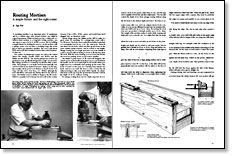
Synopsis: Don’t buy a mortising machine without first reading this article by Tage Frid, which explains how you can build a simple fixture for holding stock so you can cut mortises with a plunge router. This leaves you with a mortising setup that works just as well as an expensive machine, he says. He talks about varieties of plunge routers and how they compare, including features to look for and avoid. Then he explains how he built his mortising fixture, which he describes as looking like a big miter box. He talks about how to use it for general mortising, and an end note offers a tip on reducing tedium in setting router stops and locating stock when cutting a lot of mortises.
A mortising machine is an important piece of equipment, and in a cabinet shop with several workers one might be a good investment. Whatever kind you buy, a chain-saw or a hollow-chisel mortiser or a long-hole boring machine, you can expect to pay a lot for it, $2,000 or more. But by building a simple fixture for holding the stock to cut the mortises with a plunge router, you can have a mortising setup that works just as well as an expensive machine. The cost is only about $350, and you’ll have acquired a heavy-duty router for general shop use.
Two makes of plunge-type routers are sold in the United States—The Stanley (models 90303 and 90105) and the Makita (model 3600 B). The Stanley plunge-base routers are production tools specifically designed for rough cut-out work, like cutting out holes in countertops for kitchen sinks or lavatories. They plunge to a set depth and lock automatically, but can’t be locked at any depth in between. Stanley, by the way, has recently sold its power tool division to Bosch Power Tool Corp. (PO Box 2217, New Bern, N.C. 28560), although the tools will still be sold under the Stanley label for the next two years. The Makita router is similar in design to the Elu router, which is a popular tool in Europe but isn’t sold in this country because it has a 220v, 50-Hz. motor, and would burn out if plugged into an American outlet.
Several things about the Makita model 3600 B make it a good router for mortising. It’s a plunge-type router with a 2 3/4-HP motor. The body (motor/spindle assembly) is attached to a rectangular base by two 7/8-in. dia. steel posts. These fit into sleeves in the body, which can slide up and down on the posts (against spring tension), and be locked at any height. Plunge routing lets you begin and end a cut in the middle of a piece of stock without having to lower or lift the base from the work. With the motor running you can lower the bit into the wood by pushing down on the router’s handles.
The Makita is pretty heavy (11 lb.) and well designed. The switch can be worked without having to move your hand from the handle, but it’s not located right on the handle where you might turn it on accidentally when picking up the router. The body is locked on the posts by a latching lever instead of a knob, and you can reach this lever to raise or lower the bit without having to take your hand off the handle. An adjustable knob on the top stops the upward travel and also controls the depth of cut for ordinary routing.
From Fine Woodworking #30
For the full article, download the PDF below:
Fine Woodworking Recommended Products

Fein Turbo II HEPA Wet/Dry Dust Extractor

Hedgehog featherboards

Festool DF 500 Q-Set Domino Joiner




















Log in or create an account to post a comment.
Sign up Log in